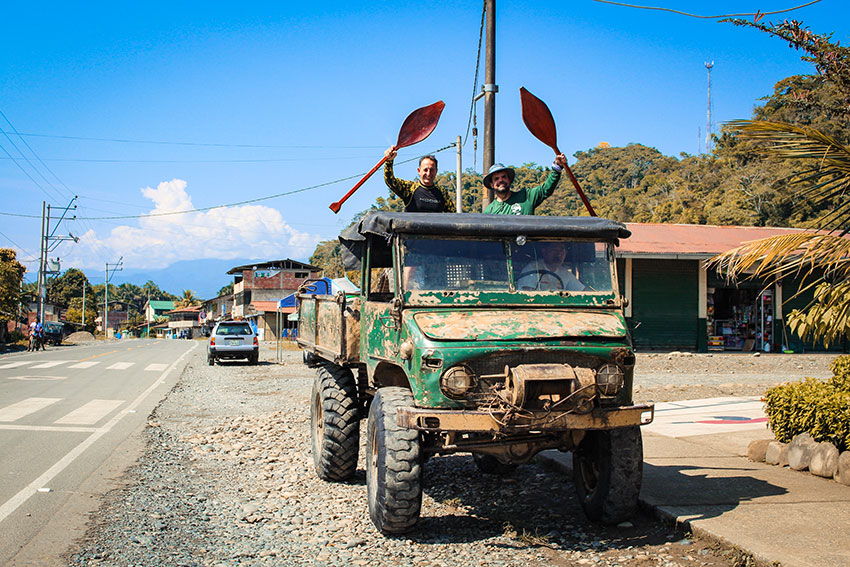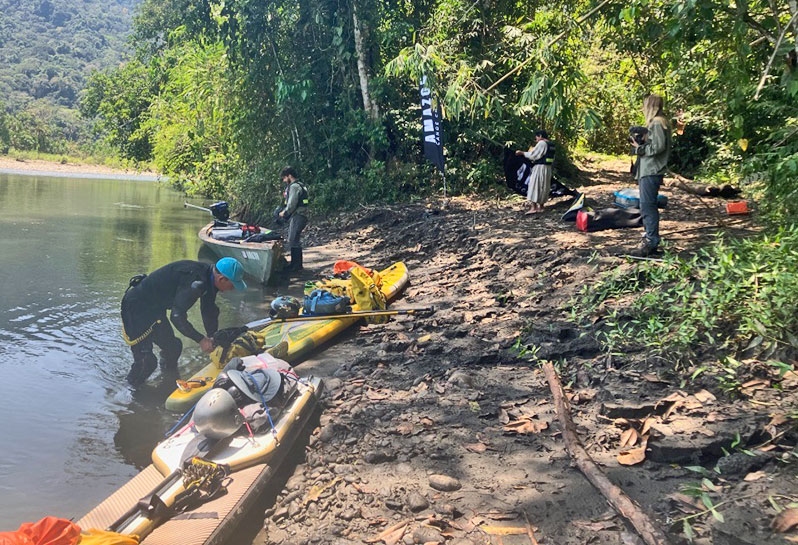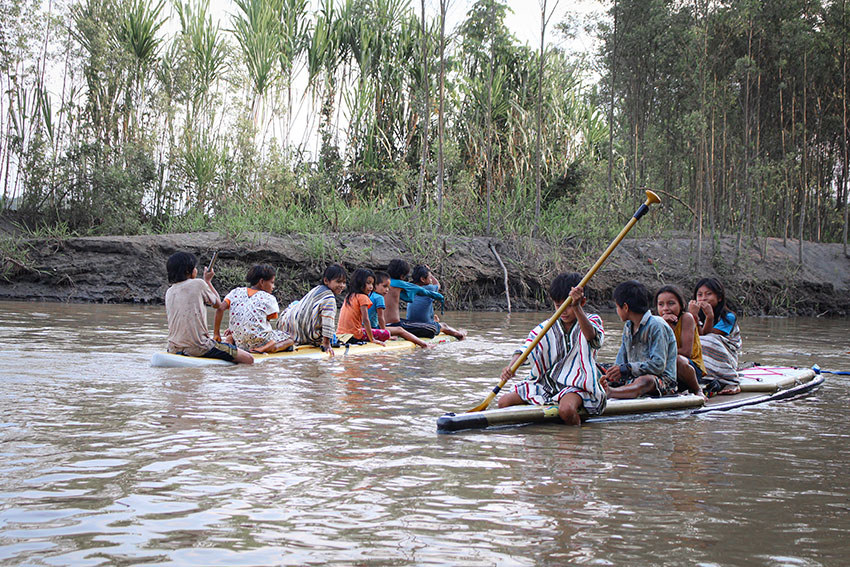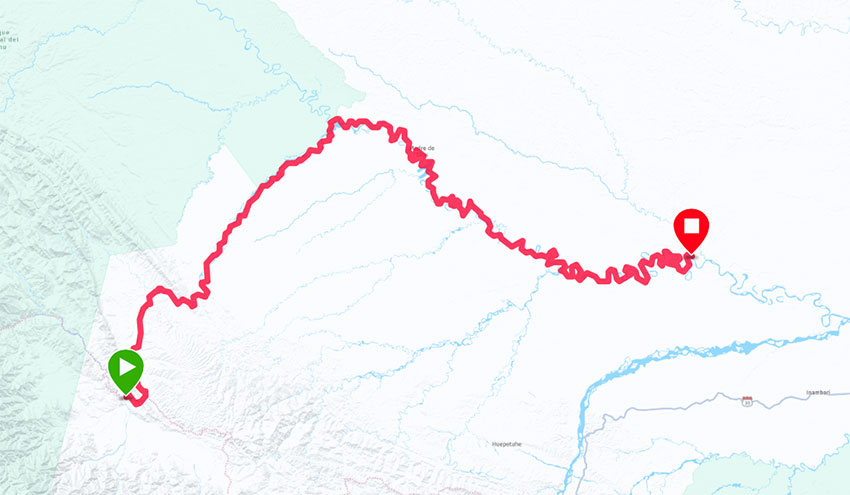330 Kilometer SUP-Adventure in rain forest of Peru
Text and Fotos: Thomas Schillig (right side)
Getting ready
We bring our SUP but also the tent, sleeping bag, food, clothes and many other things to the Amazon.
After an adventurous drive from Cusco over 4000m high mountain roads, we finally reach Pillcopata, a small town at the western end of the Amazon rainforest in Peru.
Together with Tony Bain, our reconnaissance team that tests the Madre del Dios river for navigability with stand-up paddleboards. – Or, are we perhaps the guinea pigs being eaten by the local animals? We’ll soon find out.
But just a few hours later, the all-clear is given at the briefing.
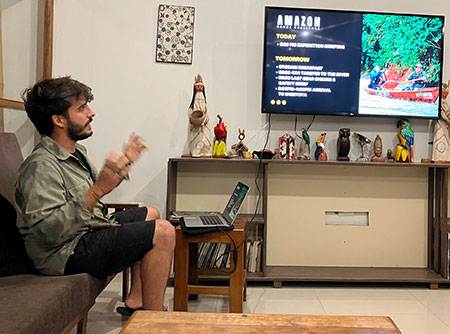
Carlos and Freya from Amazon Canon Challenge show us the 300km route and explain that the wildlife is mostly peaceful and rather reserved. But there are also a few things to bear in mind when meeting the local communities. While we will spend the night with some communities, there are also some that do not want any contact and whose banks we should avoid.
But the fact that mineral resources are sometimes mined and transported away illegally is also addressed and explains what we need to look out for.
It is information that makes our trip exciting and we can hardly wait for the next day.
THE CHALLENGE STARTS
Even the journey to the entrance to the river is an experience.
Our vehicle arrives punctually, an hour late, in front of the hostel. It is an old, rusty, partly welded-together Unimog. We heave all our luggage onto the open loading area and take a seat ourselves. The bumpy ride takes us out of the village and suddenly the driver steers us through a meter-deep river and on through the thicket of the rainforest. The path gets narrower and narrower. Branches brush our ears, the first ants inspect our luggage and clothes.
START INTO A NEW ADVENTURE
We are eagerly awaiting this challenge.
Never before had a stand-up paddler traveled in this region of the Amazon.
Finally we reach our entry point where we unload everything and prepare our SUP. It’s not so easy to set up a perfectly planned setup in the middle of the jungle where everything is wet and muddy. I succeed more badly than right, which I will regret later.
In the meantime, Angel has also arrived with the 10m long canoe. Together with Carlos and Freya from Amazon Challenge, he is accompanying this expedition. Angel belongs to the Shipetiari community where we will be guests.
His job is to ask other communities whether we or future paddlers are welcome or whether we have to spend the night on our own. Much is still unplanned here, as we are on a reconnaissance trip and no SUP has yet ventured into this area of the Amazon.
We were told it would be whitewater level 2-3 on the first day, but I decided to take my 14’x26″ Airboard Concept SUP, which has already proven itself twice on the Yukon River. From the third day onwards it will be whitewater 2 at most, but I fully expect to get wet today. I have a dry suit with me in case it rains non-stop. But at over 30°C it’s out of the question.
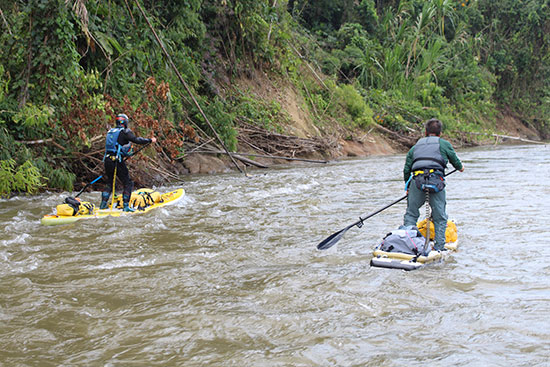
It took less than two kilometers and I’m lying in the water. Maybe it’s the unexpected underwater currents or the massive load in the wrong place on the SUP that makes my board tip over far too quickly, but it’s good to cool down. Over time, I’m learning to deal with this momentum, but I definitely need to optimize my load. Tony is obviously having more fun in the rapids with his 17″ OShea SUP.
The river does not carry much water. There are gravel islands and shallows everywhere, which have to be carefully avoided. If you’re not careful, your board will scrape over the worn stones. Luckily, Tony is an absolute river pro who knows this type of river from New Zealand. He has a satellite view and sees the situations extremely far ahead, as if he could see them from a bird’s eye view.
SHINTUYA COMMUNE
Part of our trip is to visit local communities and see how they live and learn from them.
In the late afternoon we reach the Shintuya commune, which has turned a hot spring on the left bank of the river into an excursion destination for the local population. A few simple huts have been erected for the few tourists who stray here. This evening we not only enjoy the amenities of a hot bath but are also allowed to spend the night in the huts and have enough space to repack our luggage.
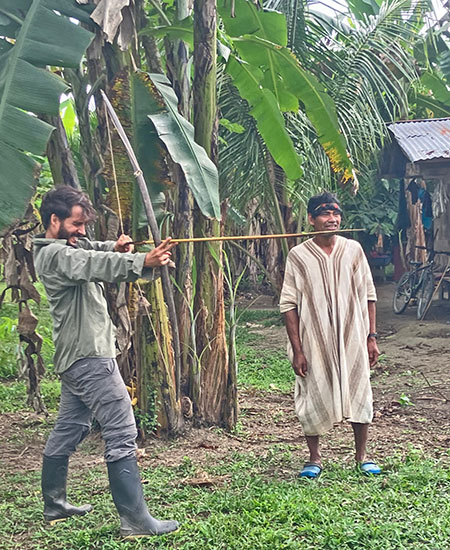
As night falls, the family from the Shintuya community treats us to an excellent dinner. Vegetables and yucca, as well as fish cooked in bamboo. A wonderful aroma wafts towards us as we open the bamboo cane and arrange the fish on our plates.
After dinner, Julio and Walter introduce us to the customs of their tribe. They show us how they make arrows for hunting from light wood, feathers and thread and invite us to make some ourselves.
An extremely delicate work in which two half feathers are glued to the back of the arrow with the help of a pitch mixture and then fixed in place with a fine thread from the pineapple.
We all sit together around the fire and Julio tells us stories about the forest and the river. He is one of the last inhabitants who grew up in the Shintuya community when it had no contact with the outside world.
While Julio tells us these stories, we get the typical tribal body painting, a kind of tattoo whose color is obtained from the essence of a fruit and will last about a week.
The river rose by over a meter overnight. There must have been quite heavy rainfall upstream, but we didn’t notice anything.
After breakfast, we load up our SUPs again. This time I distribute the luggage a little better. Less weight on the fin, but further forward.
Countless locals have already gathered on the riverbank, sitting comfortably on a small gravel bank while the children frolic in the warm water of the hot spring that flows into the river.
Word has probably gotten around that a few crazy gringos are starting here today.
Back on the water, I quickly realize that the rearrangement of the luggage makes a big difference. The board is now much smoother and more stable. It’s a hot day and there are hardly any clouds to block out the sun. Now I really want to jump into the water.
I have also optimized my clothing. Instead of trekking pants, I now paddle in swimming trunks, shin guards and rubber boots. A helmet and protectors are definitely advisable on this tour, as there are shallow spots with lots of stones and whole trees everywhere. Injuries here in such a remote area can have quite problematic consequences as help will only arrive hours if not days later.
It’s a short day of paddling. We are only 32 km down the Madre del Dios when we arrive at the Shipetiari community of Angel. Some Shipetiaris watch our arrival from the shore with excitement.
SHIPETIARI COMMUNE
Families who otherwise have little contact with Western visitors welcome us warmly and show us their culture.
A short walk takes us into the interior of the island where we are welcomed by Mateo? As soon as we sit down at his family’s large wooden table, we are invited to drink masato. Masato is a thick yucca juice, almost porridge-like, which has been fermented for three to four days. It is passed around in a large wooden bowl, received with a “gracias” and drunk with “salud”.
It’s around 4 pm when the children arrive from school. Together we go back to the river and load as many children as possible onto our SUPs one after the other. They have a lot of fun and it’s great to see the children playing around on our SUPs.
About an hour later, the whole crowd of about a dozen children is sitting at the big wooden table and quietly enjoying our big cake and the drinking chocolate that we brought as a gift.
During this time, we set up our tents right next to Mateo’s family’s wooden hut. This is probably our last camp in an inhabited area.
The people serve us a simple but nutritious meal. A typical soup like you often get in South America. With rice, some chicken and yucca, which is the staple food in this region and is grown everywhere.
The soil in this Amazon region is extremely infertile. It is actually unthinkable when you see all this greenery, but fruit and vegetables hardly thrive in this soil. To make this soil fertile, the existing trees and plants are burnt down and the soil is enriched with the ashes. This “slash and burn” method is unfortunately not entirely sustainable, but it is by no means the biggest problem of deforestation.
In the evening, we sit around the fire with the family. Masato is passed around and Matheo tells us stories about the animals of the Amazon.
We grill platanos, so-called vegetable bananas, which are served on large banana leaves.
It is a clear night and there are countless stars to be seen, but you can see lightning upstream. It is possible that these thunderstorms will cause the river to rise again. The temperatures barely fall below 20°C at night and it is far too warm in our tents, so we can’t fall asleep for a long time. Sweating, we lay on our mats without sleeping bags and listened to the countless noises coming from the thicket.
After a hearty breakfast of fish, rice and vegetables, a Shipetiari shows us how to shoot with a bow and arrow. “It’s amazing how powerful this bow is,” remarks Tony, who knows how to handle a sports bow himself. The real hunting arrows are a lot longer than the ones we made the day before yesterday. They have different detachable tips which can be changed depending on the target. It takes us a few attempts before we finally hit our target from a short distance. We are extremely touched when we are given these arrows as a parting gift.
The children are already at school and most of the adults are in the field. A few wave goodbye to us, then it’s off to the third day.
The water has risen again and the current has picked up again. We won’t need four hours for the next 50 kilometers.
MASHCO-PIRO (NOMOLE)
We also paddle through areas where strangers are not necessarily welcome.
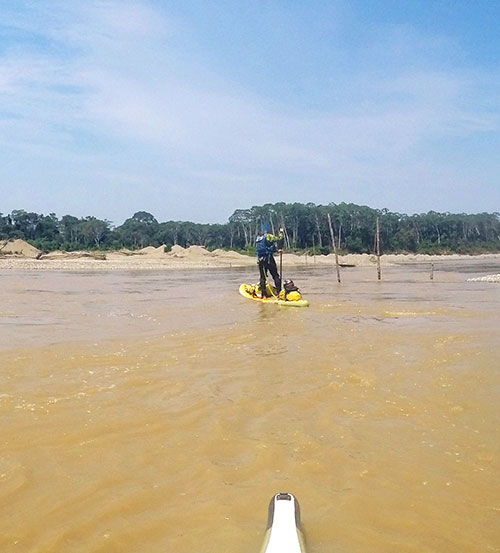
There are a few things to watch out for today, as the Mashco Piro (Nomole) live on a section on the left bank of the river. A community that does not want any contact with the outside world. Intruders into their land might not be able to tell of their visit. The only exchange this community maintains is when the village elder occasionally goes to the other side of the river to talk to a contact person. This person speaks the language of the Mashco Piro (Nomole), who otherwise do not speak Spanish, and then passes this on to the Peruvian Ministry of Culture.
We stay on the right-hand side as far as possible, with the support canoe close behind us, leaving us to choose our own route. We cross this passage without any problems, as the river is quite wide, and towards the afternoon we reach Boca Manu where our support canoe fills up with provisions. We also take this opportunity to enjoy a hot meal in a simple restaurant.
Not far away is a small airstrip in the grass where goods are occasionally handled. We were advised not to take any photos in this area as it is possible that not all goods are properly declared.
NESTOR’S PLACE
A paradise in the middle of the Amazon
We reach Nestor’s estate towards evening. We heave our SUP ten meters up the steep bank and hide it in the rainforest. Nostor says anything that is not from here makes us curious. Then we follow him for about 15 minutes on a path through the rainforest until we suddenly arrive in a large green clearing. It really is a beautiful estate! Nestor has created a little paradise here. Seven simple huts without electricity, but with their own shower and toilet, as well as a communal room protected from unwelcome guests by fine bars.
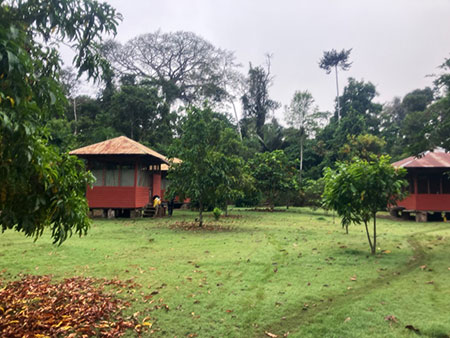
Nestor is very simple. He says he has saved up for a long time to get this property ready, but is not particularly keen to attract guests. Those who know him are welcome and he likes to live from word of mouth.
In the meantime, he has already picked some fruit from the trees and given it to us to eat. Fruits like “Caimo” and other unfamiliar names, which none of us have ever eaten and which taste super sweet.
Nestor shows us his kingdom on a night-time walk.
We walk through the rainforest on narrow paths and over tree-trunk bridges and discover various nocturnal animals such as tarantulas and monkeys, always accompanied by the breathtaking soundscape.
THE RELENTLESS SEARCH FOR GOLD
The search for natural resources in the Amazon is leaving its mark on this paradise.
Throughout the night we could hear all kinds of animal noises, which gradually became our lullaby. – A paradisiacal lullaby, and yet Nestor’s little paradise must be abandoned.
A long day of over 60 kilometers lies ahead of us. We are accompanied by countless butterflies which feast on the salt from our sweaty clothes and constantly settle on us as we paddle.
On the banks, small piles of rubble bear witness to the gold diggings which, the further we paddle downstream, get higher and higher and sometimes make it difficult for us to navigate between them. Next to them are huge machines, some of which tear down entire embankments.
Gold mining itself is perhaps not the main problem, but the way it is carried out. Gold was mined in small quantities early on, but over time more and more ruthless methods were used.
Until a few years ago, illegal mining was successfully stopped by the government and the military. In the meantime, however, they are being allowed to operate – for whatever reason.
Among other things, mercury is used to get at the gold and many of the workers are probably unaware of the danger and some of the waste water is discharged unfiltered into the river. In addition, hectares of forest are cut down and never reforested after the mining sites have been abandoned.
Another problem is that large mining companies sometimes buy land from communities and lure them into the mining towns with job offers. As a result, there are already countless abandoned communities in the area and it was not possible to find a community where we could stay overnight.
He doesn’t think much of the dry food we prepare in the bag either. And so he decides to cast his net along the riverbank after dark to catch fresh fish. After half an hour, we have already caught enough for the four of us and the fish is roasted on the campfire.
Suddenly he shines his flashlight onto the shore. Two eyes of a cayman sparkle in the dark. However, the small crocodiles are extremely shy and pose no danger to us.
THE SILENCE IS OVER
Goldgräber-Städte beleben das Ufer und den Fluss
We are somewhat surprised on the morning of the fifth day when we discover fresh tracks of a jaguar near our tents. We were obviously not completely alone.
As it is already light before six o’clock, we are ready to go early and paddle off at 8 o’clock. A rain front looms ahead of us. We are glad of every cloud that provides some shade, as it makes paddling much more bearable than paddling in the blazing sun at over 30°C. The rain only hits us briefly, just 15 minutes of drizzle and it’s all over.
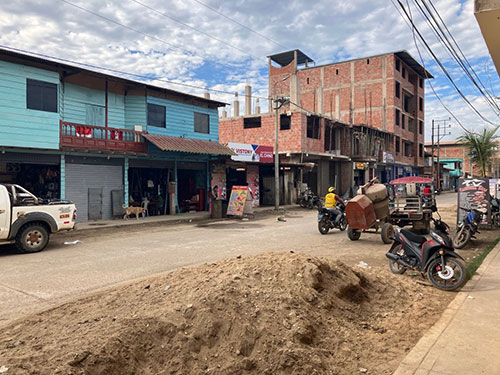
After almost 60 kilometers of paddling, we reach Boca Colorado. A gold mining town where there are countless stores and workshops to maintain the machines. We take the opportunity to replenish our water supplies. But we don’t stay here for long, because it will be dark in three hours and we want to paddle another ten kilometers and find a quiet place on the shore.
When we arrive at a suitable bend in the river, everything has to happen very quickly. For safety reasons, the SUPs are immediately hidden in a hollow, as we don’t want to attract attention.
The miners and the inhabitants are not the problem, but in recent years there have been repeated attacks on miners by bandits coming upriver from Puerto Maldonado. We gringos could look wealthy with our SUPs and possibly be a target, as we were already asked in Boca Colorado if we were gold buyers. With no visible SUP and just a wooden canoe on the bank, we shouldn’t attract much attention when night falls.
FINAL DAY
Every adventure comes to an end
It is the last day and we realize that this adventure is slowly coming to an end. Even though we are beginning to feel the miles in our muscles, we are enjoying the last twists and turns of this breathtaking river.
We have the feeling that word has spread about the presence of the two gringos paddling down the river standing up. Whereas at first the boat drivers were hesitant to wave back, we are now greeted with a cheerful “Hola” and bananas are handed to us from boats.
It also turns out that the bandit problem has apparently been solved in recent months. “We’ve sorted them out,” said a miner laughing with a clear hand gesture.
In the afternoon of the sixth day, we reach our destination, the Los Amigos Biological Station.
We have made it! After 333km we have arrived at our destination.
But it’s not the kilometers that count. It is the unique and unparalleled encounters that we were able to experience that make this adventure incomparable.
We are warmly welcomed and celebrated by Carlos and Angel. But we are still in the middle of the Amazon rainforest. High above the treetops on a small plateau is this research station, which even has its own DNA laboratory.
Not only are countless animal species being researched here, but also the effects of the mines on the water and the entire atmosphere.
It is a little luxury that we can enjoy here. Everyone has their own bungalow and enough space to dry all their wet clothes and pack them neatly.
The next day we have to leave the Amazon for good. We wait on the banks of the Madre del Dios for a speedboat to take us to Puerto Maldonado. During the three-hour trip down the river, everyone is absorbed. There are so many unforgettable impressions to process. The encounters with the communities were unique and we will always remember them. And in the back of our minds, the thought that this river leads from Puerto Maldonado further west to Bolivia. – To be continued…? Perhaps.
Tony Bain
New Zealand
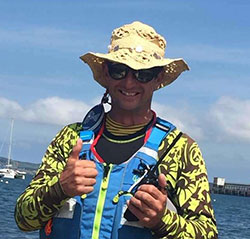
A “SUPMADKIWI”. Born in New Zealand and now living in North Wales and running a SUP school. Growing up on farms in the South Island of New Zealand, I have always had a strong interest in outdoor adventures. Peru and Canada have always been countries I’ve wanted to explore.
For the past ten years I’ve enjoyed exploring the limits. The first big adventure was in April 2013 when the four of us walked, cycled and paddled 354km along the longest river in the UK, the River Severn.
In 2017, I was the first person to circumnavigate the Isle of Anglesey (on the north coast of Wales) non-stop. The tour took 18.5 hours.
Unfortunately, I did not complete the Yukon River Quest (715 km), but I returned to the Yukon 1000 in 2018 and was one of the first 6 people in the world to take part.
This involves paddling over 1600km in ten days through the Canadian wilderness and Alaska.
In New Zealand I paddled most of the big lakes in the South Island and paddled many rivers in the South Island including Clutha (338km in a 4 day trip), Rakaia, Waimakariri and Buller from the Alps to the ocean.
Thomas Schillig (Author)
Switzerland
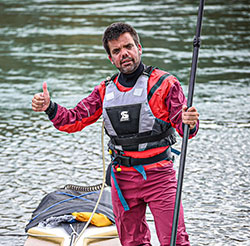
I’ve been paddling since 2011 and have been working for the Swiss SUP brand Airboard for ten years, where I’m jointly responsible for many innovations in inflatable SUPs.
I’ve been addicted to long-distance since 2018. In 2020 – due to travel restrictions – I circumnavigated the 25 largest Swiss lakes, including a 24-hour non-stop circumnavigation on the largest lake within the country. In 2021, I paddled the 10 largest Swiss rivers, including whitewater sections.
Since traveling is allowed again, I travel internationally and paddle more than 2500 km a year. My highlight: completing the Yukon River Quest (715 km) for the second time, this time in second place.
When I’m not paddling, I’m often out in the mountains on my mountain bike or snow bodyboarding in winter.
I have a special relationship with the Peruvian Amazon. I was already in the Madre del Dios region more than 10 years ago, but without a SUP. I was already fascinated by the Amazon back then, but I never thought I would really return to this amazing nature on the SUP.
Angel
Shipetiari Community

Angel comes from the Shipitiari community. This indigenous community belongs to the indigenous Machiguenga people. They are not originally from this area, but moved here to escape slavery to the rubber barons from the Urubamba region.
Carlos & Freya
Amazon Canoe Challange
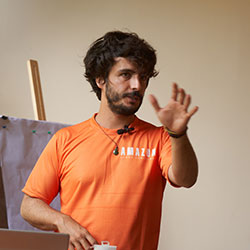
When we dreamed of the Amazon Canoe Challenge, we wanted to create an experience that would not only be an unforgettable adventure, but one that would actually create positive change. Our desire to give back is what drives us – to create real impact through community empowerment, partnerships with local organizations and training.
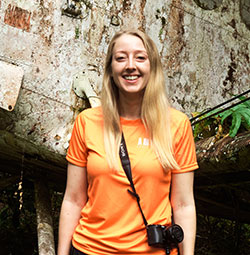
Through tourism, we intend to support local communities with an alternative source of income, reducing dependence on the illegal logging, oil and drug trafficking industries that cause so much damage to the environment and the people in these areas. We may be small, but we are striving for big change.
Mashco-Piro
The Mashco-Piro or Mascho Piro, also known as the Cujareño people and Nomole, are an indigenous tribe of nomadic hunter-gatherers who inhabit the remote regions of the Amazon rainforest. They live in Manú National Park in the Madre de Dios Region in Peru. They have in the past actively avoided contact with non-native peoples.
In 1894, most of the Mashco-Piro tribe was slaughtered by the private army of Carlos Fitzcarrald, in the upper Manú River area. Many Mascho-Piro natives were also enslaved by Fitzcarrald’s foreman, Carlos Scharff between 1897-1909 along the Purús and Madre de Dios Rivers. The survivors retreated to the remote forest areas. The sightings of the Mashco-Piro tribe members increased in the 21st century. According to the anthropologist Glenn Shepard, who had an encounter with the Mashco-Piro in 1999, the increased sightings of the tribe could be due to illegal logging in the area and low-flying aircraft associated with oil and gas exploration.
In September 2007, a group of ecologists filmed about 20 members of the Mashco-Piro tribe from a helicopter flying above the Alto Purús national park. The group had established camp on the banks of the Las Piedras river near the Peruvian and Brazilian border. Scientists believe that the tribe prefers to construct palm-leaf huts on riverbanks during the dry season for fishing. During the wet season, they retreat to the rain forest. Similar huts were spotted in the 1980s.
In October 2011, the Peru Ministry of Environment released a video of a few Mashco-Piros, taken by some travelers. Gabriella Galli, an Italian visitor to the park, also captured a photograph of the tribe members.
In 2012, Survival International released some new photographs of the tribe members. The archaeologist Diego Cortijo of the Spanish Geographical Society claimed to have captured photographs of a Mashco-Piro family from the Manú National Park, while on an expedition along the Madre de Dios River in search of petroglyphs. However, this claim to the photograph was subsequently disputed by Jean-Paul Van Belle who claimed to have taken these pictures 3 weeks earlier. His local guide Nicolas “Shaco” Flores, who was found dead six days later with a bamboo-tipped arrow stuck in his heart, is believed to have been killed by members of the Mashco-Piro tribe.
In August 2013, the BBC reported that a group of Mashco-Piros had been seen apparently asking neighboring villagers for food. The Peruvian government has banned contact with the Mashco-Piros for fear that they might be infected by strangers with diseases to which the Mashco-Piros have not built up immunity.
Source: Wikipedia

